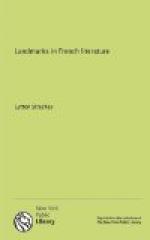While the Chansons de Geste were developing in numerous cycles of varying merit, another group of narrative poems, created under different influences, came into being. These were the Romans Bretons, a series of romances in verse, inspired by the Celtic myths and traditions which still lingered in Brittany and England. The spirit of these poems was very different from that of the Chansons de Geste. The latter were the typical offspring of the French genius—positive, definite, materialistic; the former were impregnated with all the dreaminess, the mystery, and the romantic spirituality of the Celt. The legends upon which they were based revolved for the most part round the history of King Arthur and his knights; they told of the strange adventures of Lancelot, of the marvellous quest of the Holy Grail, of the overwhelming and fatal loves of Tristan and Yseult. The stories gained an immense popularity in France, but they did not long retain their original character. In the crucible of the facile and successful Chretien de Troyes, who wrote towards the close of the twelfth century, they assumed a new complexion; their mystical strangeness became transmuted into the more commonplace magic of wizards and conjurers, while their elevated, immaterial conception of love was replaced by the superfine affectations of a mundane gallantry. Nothing shows more clearly at what an early date, and with what strength, the most characteristic qualities of French literature were developed, than the way in which the vague imaginations of the Celtic romances were metamorphosed by French writers into the unambiguous elegances of civilized life.
Both the Chansons de Geste and the Romans Bretons were aristocratic literature: they were concerned with the life and ideals—the martial prowess, the chivalric devotion, the soaring honour—of the great nobles of the age. But now another form of literature arose which depicted, in short verse narratives, the more ordinary conditions of middle-class life. These Fabliaux,




